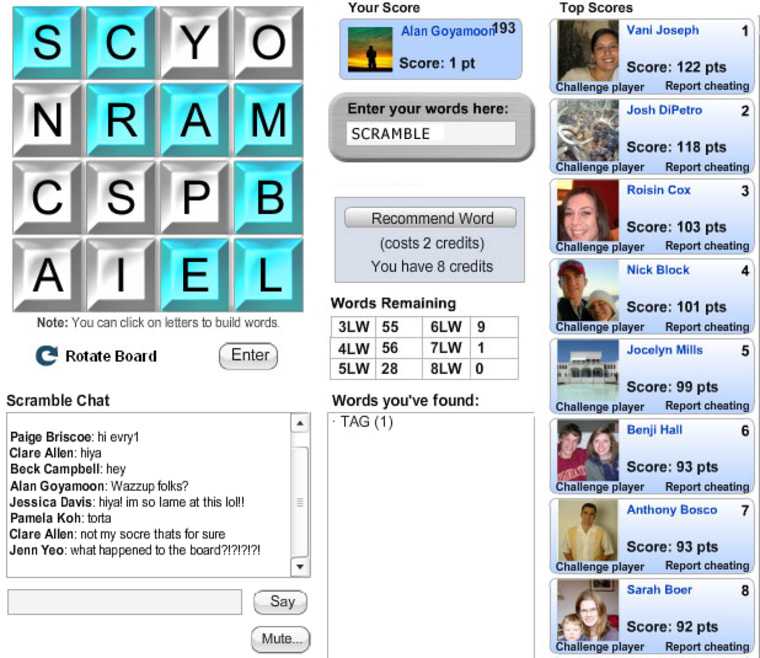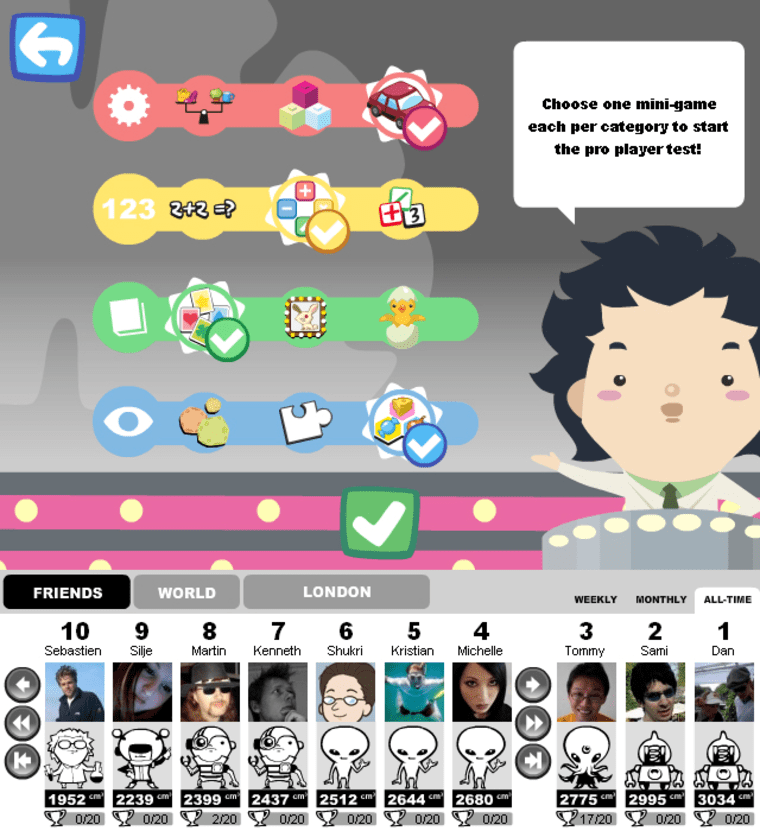Before you play a game called “Who Has The Biggest Brain?” you have to ask yourself: Do I really want to know the answer to that question?
After all, this is a game that will run you through a battery of tests and then, with the mercilessness of a fifth-grade teacher, assess your intelligence based on your performance. More importantly, since this is a game that you play on Facebook, it will then show your friends and family members how your gray matter stacks up against theirs.
And while you may believe yourself to be some sort of piping hot genius, there can be some hard truths learned here – i.e. you and everyone you know may discover that your dumb-as-a-rock dorm-mate from college possesses a brain with the computational powers of a robot, while you have the cabesa of a lowly Neanderthal. (Not that I’m speaking from personal experience or anything).
Such is the cruel nature of playing games on social networks.
But just ask any “Scrabulous”…er…“Scrabble” fan, and they’ll tell you that one of the hottest (or is it coolest?) new places to play games isn’t on a Wii or a PlayStation 3, it’s on sites such as Facebook and MySpace. Whether it’s a brain game like “Biggest Brain,” a card game like “Texas Hold’Em,” or a game called “Friends for Sale” in which you buy and sell your friends as if they were pets – social networks are offering up hundreds of gaming applications to play for free. More importantly, these networks are making it easy for people to combine playing games and socializing with friends into one convenient digital package that even technological Neanderthals can use.
Certainly at last month’s Casual Connect – a conference for the casual games industry – social-network games were the topic everyone seemed to be talking about. Many in the biz were buzzing about the way these sprawling friendship networks are opening up digital gaming to new audiences while, at the same time, unleashing entirely new types of games on the world.
Kristian Segerstrale, CEO and co-founder of gaming company Playfish, even called social networks “the greatest game platform that has ever been built.”
The more things change…
Mark Pincus, founder and CEO of fast-rising game company Zynga, points out that games used to be inherently social things – back when board and card games existed in the real world and we gathered around a real table with real friends to play them.
With the advent of video games, playtime became a more solitary endeavor. And while the Internet has allowed gaming to return to its social roots, Pincus points out that the awkward gyrations required to find friends online and play games with them has been a deterrent for most folks.

But with the rise of MyFace and Spacebook, all your friends are now gathered online in one convenient place. “And what we’re starting to see is that as the friction comes down so that you can – in a click or two – be in a game and, even more importantly, be in a game with somebody you know – all of a sudden were seeing usage explode,” Pincus says.
The numbers are certainly awe-inspiring. For example, Zynga’s “Texas Hold’Em,” which appears on Facebook, MySpace, Bebo and Hi5, pulls in 900,000 players every day. Meanwhile, Playfish’s “Biggest Brain” boasts some 3 million monthly players on Facebook.
Part of what makes these games so convenient and easy to get started with is the fact that players don’t have to do much digging to find games they’ll like. Social-network games tend to spread via word of mouth as friends invite each other to play what they’re playing. And what a win that is for game developers.
“Here you’re putting something out there for free in front of a bunch of people and those people are spreading the word for you,” says Bret Terrill, a blogger who covers social gaming. “And that’s kind of amazing.”
An entirely different platform
During a talk at Casual Connect, Playfish’s Segerstrale told game developers it was imperative that they “think of social networks as an entirely new platform. You cannot approach this market like the traditional video game market. Social gaming has entirely different criteria for success.”
He says that for games to flourish on a site like Facebook they have to be not only easy to jump into, but they must be inherently more fun to play together than solo. To that end, Playfish games such as “Biggest Brain” and “Word Challenge” all feature leaderboards that display pictures of your friends and show you how their scores stack up to yours. And tracking each other’s progress really is the fun (albeit sometimes humiliating) part of playing.
Terrill points out that another vital component for success is a little something called “asynchronous gameplay” – that is, you and your friends shouldn’t have to be online at the same time to play games together. The much-contested and groundbreaking game “Scrabulous,” for example, rocketed to success because it allowed players to take turns playing the Scrabble-like game at their leisure, lobbing moves back and forth with friends across time and space.
Bite me
“I think what’s important is giving users an interesting way to interact with each other,” says Blake Commagere, the developer behind the “Zombies,” “Vampires,” “Werewolves” and “Slayers” games.
Like many developers making applications for social networks, Commagere is a lone dude working out of his house on a shoestring budget. A fan of horror movies, he created his “Zombies” game last summer over the course of a couple of weekends.
His games can now be found on MySpace, Facebook, Bebo and Hi5 and have been installed more than 25 million times – this despite the fact they don’t feature any fancy CGI effects or require complicated button combinations to play.
When it comes to games on social networks, “If the game design is good and it really does leverage the fact that you’re playing with your friends, then it really doesn’t matter what the graphics are like,” Terrill says.
Indeed, like many social-network games, Commagere’s titles are simple in look and function – you select friends from your network and click on their picture to “bite” them (which also invites them to play the game with you). By doing this you power up your own personal zombie, further leveling up as you “fight” other zombies and “feed” your friends to them.
“My games wouldn’t work outside of a social network,” Commagere points out.
Games such as “Zombies” are changing the definition of what a “game” is as developers craft new kinds of gameplay that make use of this unique social environment.
Segerstrale points to “Friends for Sale” – which allows players to buy and sell their friends in a kind of stock-market style bidding war – as a prime example of the innovation coming out of social networks.
“This proves you can throw away the book on game design and still be successful,” he says.
Finding the right formula
But working in brand new territory comes with its share of challenges.
Trying to figure out what kind of gameplay is going to be fun in this new setting is one of them, Commagere says. Plus, he and others point out that Facebook and MySpace are constantly evolving and changing.
“By virtue of the fact that those Web sites aren’t done you’re never going to be done either,” he says.
Making money off these free games is also a challenge. Commagere, like many developers, makes money through advertisements that appear in his games. And while he won’t say how much he makes, he will say that it’s enough to make a living. Meanwhile, Playfish brings in cash through ads as well as by offering premium game features for a fee. Still others charge small fees to buy virtual items that can be used inside the games.
“I think we’re all kind of experimenting, trying to find out what the right formula is,” Commagere says.
